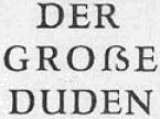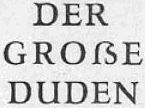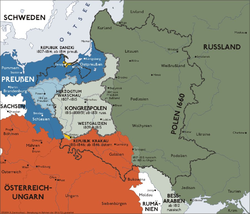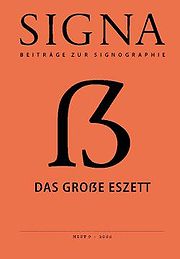
Capital ß
Encyclopedia


ß
In the German alphabet, ß is a letter that originated as a ligature of ss or sz. Like double "s", it is pronounced as an , but in standard spelling, it is only used after long vowels and diphthongs, while ss is used after short vowels...
. Sharp s is nearly unique among the letters of the Latin alphabet
Latin alphabet
The Latin alphabet, also called the Roman alphabet, is the most recognized alphabet used in the world today. It evolved from a western variety of the Greek alphabet called the Cumaean alphabet, which was adopted and modified by the Etruscans who ruled early Rome...
in that it has no traditional upper case form (one of the few other examples is kra
Kra (letter)
Kra is a character formerly used to write the Kalaallisut language of Greenland and is now only found in the Labrador Inuit Language of Inuttitut, a distinct Inuktitut dialect. It is visually similar to a Latin small capital letter K and the Greek letter kappa κ.It is used to denote the sound...
, which was used in Greenlandic). This is because it never occurs initially in German text, and traditional German printing (which used blackletter
Blackletter
Blackletter, also known as Gothic script, Gothic minuscule, or Textura, was a script used throughout Western Europe from approximately 1150 to well into the 17th century. It continued to be used for the German language until the 20th century. Fraktur is a notable script of this type, and sometimes...
) never used all-caps. When using all-caps, the current spelling rules require the replacement of ß with SS or SZ.
There have been repeated attempts to introduce one majuscule ß. Such letterforms can be found in some old German books dating back to the late 19th century and some modern signage and product design. One of the best known examples is the East German 1957 Duden
Duden
The Duden is a German dictionary, first published by Konrad Duden in 1880.Currently the Duden is in its 25th edition and published in 12 volumes, each covering different aspects like loan words, etymology, pronunciation, synonyms, etc...
.
Inclusion in Universal Character Set
A proposal by Andreas Stötzner to the Unicode ConsortiumUnicode Consortium
The Unicode Consortium is a non-profit organization that coordinates the development of the Unicode standard. Its stated goal is to eventually replace existing character encoding schemes with Unicode and its standard Unicode Transformation Format schemes, claiming that many of the existing...
for the inclusion of capital double s in the Universal Character Set
Universal Character Set
The Universal Character Set , defined by the International Standard ISO/IEC 10646, Information technology — Universal multiple-octet coded character set , is a standard set of characters upon which many character encodings are based...
was rejected in 2004, on the basis that capital ß is a typographical issue, and therefore not suitable for character encoding. A reworked version of Stötzner's proposal was submitted on 25 April 2007 by DIN
Din
DIN or Din or din can have several meanings:* A din is a loud noise.* Dīn, an Arabic term meaning "religion" or "way of life".* Din is one of the ten aspects of the Ein Sof in Kabbalah ....
. The proposal suggested the Unicode name LATIN CAPITAL LETTER SHARP S. The proposal has been adopted and the character was added as Unicode character "" U+1E9E LATIN CAPITAL LETTER SHARP S when Unicode 5.1 was released, on 4 April 2008.
Support in computer operating systems
Because of the recent adoption of this character as Unicode, even recent operating systems may not yet recognizeẞ (XML notation for this codepoint). On Mac OS XMac OS X
Mac OS X is a series of Unix-based operating systems and graphical user interfaces developed, marketed, and sold by Apple Inc. Since 2002, has been included with all new Macintosh computer systems...
10.6 version only one font includes it, Geneva Regular. Until the current iOS version there's no official support.
Glyph designs

Long s
The long, medial or descending s is a form of the minuscule letter s formerly used where s occurred in the middle or at the beginning of a word, for example "ſinfulneſs" . The modern letterform was called the terminal, round, or short s.-History:The long s is derived from the old Roman cursive...
and a round z, but applying those principles to the design of uppercase rather than lowercase letters.
The most common is the design used on the cover of Signa magazine, which joins an ascender made from an inverted capital U to an ezh
Ezh (letter)
Ezh is a letter in the International Phonetic Alphabet , representing the voiced postalveolar fricative consonant. It is also called the "tailed z". Example: vision . It is pronounced as the "s" in "treasure" or the "si" in the word "precision"...
-like partial capital letter Z. Another similar design uses the ascender of a capital letter 'F
F
F is the sixth letter in the basic modern Latin alphabet.-History:The origin of ⟨f⟩ is the Semitic letter vâv that represented a sound like or . Graphically, it originally probably depicted either a hook or a club...
' instead of the inverted U ascender. A radically different design that still reflects the same typographic history consists of two capital letters S joined by a short stroke at the top to form a ligature.
, typographers have yet to agree on a standard form for the letter capital ẞ, as they did in 1903 when an association of German printers and type foundries agreed on the "Sulzbacher Form" as standard for the lowercase ß.
Further reading
- Das große Eszett. In: Signa, Heft Nr. 9. Edition Waechterpappel, Grimma 2006, ISBN 3-933629-17-9. (in German)

